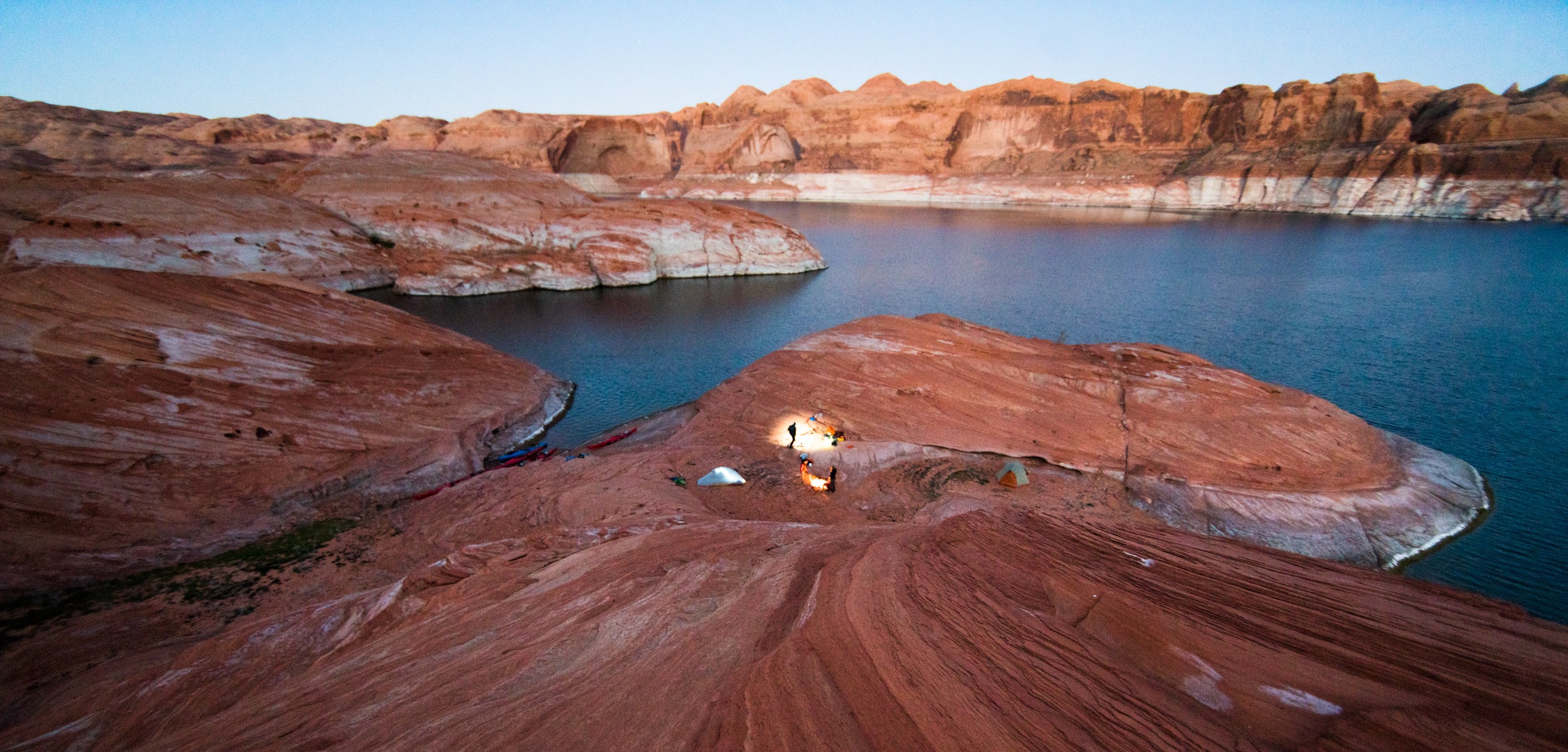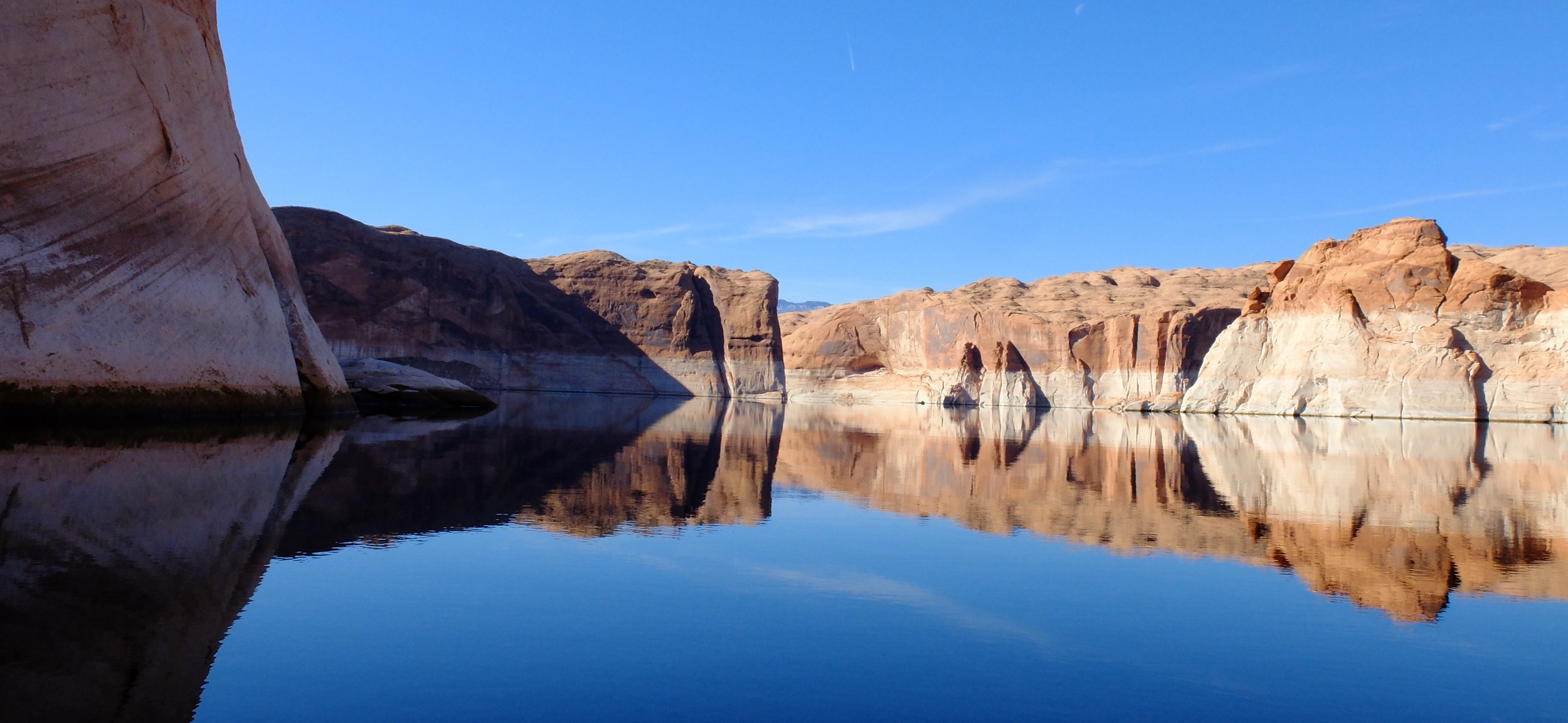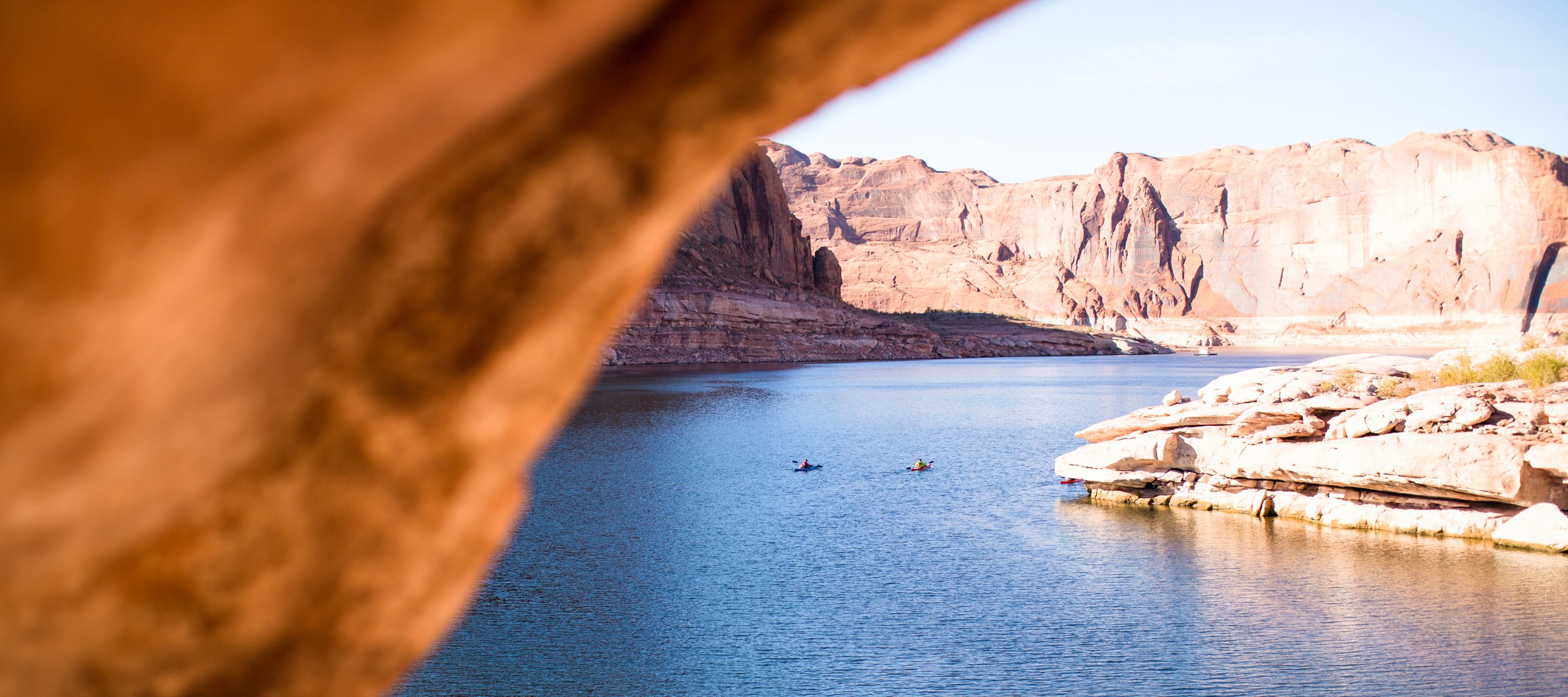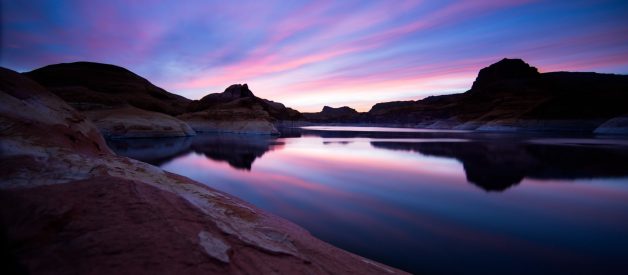By Sinjin Eberle
 Lake Powell sunset ? Photo by Forest Woodward
Lake Powell sunset ? Photo by Forest Woodward
Rebecca Solnit?s recent article, Letter to a Drowned Canyon, is a beautiful expose on the situation facing Lake Powell and the greater Colorado River. While she brings up some important points, we disagree with some of her assertions.
Here?s why.
In 2015 I was fortunate to be included on a film expedition across the Colorado River Basin with the CNN television show The Wonder List with Bill Weir. We followed the river, from its headwaters high in the Colorado Rockies to the arid desert in Southern California and Nevada over the course of a couple of weeks, filming locations and talking to people, breathing in the desert air and lying on our backs at night shooting time lapses of spinning galaxies millions of light years away. I have known since a young boy that there was a strong desire by many people who would love nothing more than to rip down the dam and free Glen Canyon ? the heartfelt yearning to right a wrong, finally bring justice to the place by tossing a few well-timed sticks of dynamite over the edge, blasting an orifice in the concrete just big enough to allow the power of water to do the rest. I read Abbey?s Monkey Wrench Gang, I get it. But it wasn?t until I was on the CNN trip did I discover another option, maybe a better one that may not have the explosive drama of charges of TNT, but would both rectify the immediate emotional gash in the spirits of so many people. This solution could also be the vehicle for saving enormous quantities of the most valuable resource in the southwest: water.
The term Fill Mead First is even catchy by name, and the moniker itself instantly conjures up a seemingly logical, but misguided, strategy for water supply management on the Colorado River. The idea is this ? instead of maintaining the pair of huge reservoirs in one of the hottest and driest regions of the country, drain down Lake Powell and move most of its water through Grand Canyon and store it in Lake Mead. Since both lakes are less than half full, and Lake Mead is the larger of the two and lies in less porous rock, it would be able to handle the storage of both (in the situation we currently find ourselves with in the Colorado River Basin). Lake Mead would do the storage, and Glen Canyon could begin the process of healing itself.
 Lake Powell?s substantial ?bathtub ring,? represents how much water is not resting in the reservoir ? Photo by Sinjin Eberle
Lake Powell?s substantial ?bathtub ring,? represents how much water is not resting in the reservoir ? Photo by Sinjin Eberle
Looking down from space, the Colorado River flows (generally) south through eastern Utah, with the San Juan joining it from the east just above the Utah-Arizona border, forming Glen Canyon (and now, Lake Powell). 57 lake miles later, the Colorado then passes through Glen Canyon Dam near the town of Page, Arizona, before flowing more than 280 miles through Grand Canyon, before pausing again in the slackwater of Lake Mead behind Hoover Dam. Lake Mead is the largest manmade reservoir in the country, spreading across a vast area in the middle of the parched Mojave Desert. Together, when full, the two reservoirs store over 50 million acre feet of water (an acre foot is the amount of water that would fill a football-field size pool, one foot deep). Lake Mead stores about 27 million acre feet (MAF), while Lake Powell stores just over 24 MAF ? importantly, when full.
Power generation is another important component of the dams, and the fact that hydropower works best when the lake behind the dam is full; more pressure from all that water turns the turbines more efficiently. As the water level behind the dam drops, pressure on the turbine decreases, losing the ability to turn them faster and generate maximum power. Drop the lake low enough, and the turbines cannot turn at all, rendering them useless.
The Fill Mead First logic reads like this ? because Lake Powell is so expansive, covering roughly 250 square miles when full, with highly porous sandstone underlying the lake seemingly seeping millions of gallons of water every year, added to many tons of sediment coming down the river and settling on the bottom of the lake year after year after year; if Lake Powell were drained to a level where it was basically no longer a lake, bypassing Glen Canyon Dam, all that water could be collected in a single, larger pool, in Lake Mead. Lake Powell would shrink back to a figment of itself, like a shriveled earthworm lying on a hot sidewalk, with all its lake water living in Mead. Glen Canyon could then be allowed the process of reviving itself, returning to its majestic and spiritual glory. Billions of gallons of Colorado River water would be saved, and outdoor recreationalists young and old could suddenly bask in the renewed glow of a long-lost lover. This pair of vastly depleted lakes (Mead is not quite 40% full while Powell is holding barely half of its capacity) could be turned into one, topped out, more efficient reservoir.
The problem is, it?s too soon, and the science doesn?t work out. Not yet.
There are 5 key reasons why the Fill Mead First argument doesn?t hold water, and while each of them on their own could be a good enough reason to look past the reality of the situation, together they make a compelling case for keeping Glen Canyon Dam in place, at least for now. Make no mistake, so many people would be thrilled to see the solution that the original engineer who designed the dam, Floyd Dominy, stated himself. The best way to breach Glen Canyon Dam is not blow it up, but drill some giant holes in the bypass tunnels and let the water essentially rot out the bottom of the dam. Who needs all those theatrics when you can just let the innate power of water and some flashy cavitation do the job for you?
Recently, highly regarded author Rebecca Solnit published an article about her experience with Lake Powell, and described an incredibly beautiful time in Dungeon Canyon and surrounding slots, while explaining some history and purpose behind the creation of Lake Powell. Near the end of her piece, though, Ms. Solnit veers off into the wrong lane, crashing into some more contemporary science that even some detractors are coming to agree with. Three of the 5 key arguments that Fill Mead First proponents use to make their case have simply been proven incorrect. A recent, comprehensive study out of Utah State University, authored by Jack Schmidt, has finally put some real science and methodological practice behind the assumptions driving the Fill Mead First argument. The other two are simply a mix of administrative reality coupled with the cold hard truth of growth and sustainability in one of the fastest growing regions of the country, the tradeoff being the signing of the death warrant for at least 5 more western rivers.
Evaporation from the surface Lake Powell is often the first point cited by those who wish the lake away. Undoubtedly, a giant body of water sitting in the middle of a southwestern desert does evaporate huge quantities of valuable water. Some people estimate that Lake Powell on its own evaporates around 600,000 acre feet of water per year, and eye-popping amount on the surface. The logic goes that if much of that water was moved down to Lake Mead, the surface evaporation between the two lakes would dramatically decrease, since only one lake is sprawling across the desert. But it?s false, and the Schmidt study concludes that if there is essentially any presence of water in Lake Powell, that even as it is drained down the evaporation would be essentially the same. Since it is unlikely that Powell would ever be truly empty, moving most of its water to Mead would be a wash rather than a significant benefit.
 Sandstone ? Photo by Forest Woodward
Sandstone ? Photo by Forest Woodward
Seepage through the sandstone is also commonly thought about when it comes to water loss. That?s because Powell sits in a highly porous Navajo and Wingate sandstone strata, water must be seeping from inside the lake, through the sandstone, and ?away? in great quantities. Again, the Schmidt study refutes this claim. In their research, Schmidt?s study shows that water losses through seepage are much less than in years past. The conclusion may be that the rock has now become so saturated that it has essentially armored itself from more significant water loss ? the kitchen colander has become more like a stainless-steel mixing bowl. It is likely that the seepage loss was significant in the early decades of the lake, but now, not so much.
With two major, silty, sandy western rivers dumping into one giant, stagnant pool of water in the middle of a hot climate, another concern about the dwindling usefulness of Lake Powell is that it is filling up with sediment. And generally speaking, it is, but not the way most people think. In my youth, our family would run the San Juan River from Mexican Hat to Clay Hills Crossing at least once a year. My first trip was when I was about 10 years old, and each adventure was glorious. I remember days of drifting past a spectacular slot canyon called Oljeto Wash, rowing casually onto the flat expanse of Lake Powell, and just as the current began to slow, the parking area would magically appear at the takeout ? just like someone had planned it. But as the years went on, the rowing became harder and longer, a real slog out in the hot sun ? a few years ago it seemed like we spent the better part of a full day dragging our rafts off sandbars the entire stretch past Grand Gulch, and the mouth of Oljeto Wash was behind a giant, 20-ft tall wall of sand. Which perfectly illustrates another point in the Schmidt study ? the sediment is not primarily gathering behind the dam, it is settling far upstream as the rivers enter the lake. The San Juan enters Lake Powell at mile 57, while the Colorado slows down starting at Hite, 140 miles from the dam itself. As that water slows, it drops the sand and silt it carried down from the high country at the dual, gaping mouths of the lake, not at the foot closest to the dam. In December, 2015, I paddled from Halls Crossing to Page ? when we put in at Halls the lake was brown, but when we took out at Antelope Point the water was blue ? most of the sediment had settled out across the 93 miles and 7 years it takes the water to move from one end of the lake to the other. Jack Schmidt and his team reviewed a 2005 sonar study, mapping generally where the sediment is being deposited. The answer is that the underwater mountain of sediment is dozens of miles upstream from the dam, and at the rate it is creeping west, the sediment problem of Lake Powell is decades from having any meaningful impact.
 Glass blue waters where the Escalante use to flow ? Photo by Sinjin Eberle
Glass blue waters where the Escalante use to flow ? Photo by Sinjin Eberle
The fourth main point is a legal one, apart from the scientific realm of the Utah State study. In 1922, the Colorado River Compact divided up the river into two parts, the Upper Basin and the Lower Basin. The line of demarcation between the two identified is a gauging station at Lee?s Ferry, Arizona, just before the rivers slips gently towards the Grand Canyon. The formula was pretty simple ? using an exceptionally wet 10-year weather cycle as the baseline, the authors of the compact assumed that there was about 15 million acre feet of water in the river every year. They then divided the river equally ? about 7.5 MAF for the Upper Basin states (Colorado, Utah, Wyoming, and New Mexico) and 7.5 MAF for the Lower Basin (Arizona, California, and Nevada). Simple enough. A decade or so later, Mexico came into the picture and negotiated a bit of water too, since the Colorado River flowed over their border ? that amount is about 1.5 MAF. That simple math already takes more water out of the river that was originally assumed existed (7.5 + 7.5 + 1.5 = 16.5 MAF) and leaving nothing for the health of the river itself. As a result, the Upper Basin states must, by law, flow 8.23 MAF of water per year (on a 10-year rolling average) past the gauge at Lee?s Ferry, keeping the lower basin states wet. Generally speaking, the river has rarely ?actually? had more than about 13 MAF flowing through it, and with climate impacts looming, the situation could get much worse. Subsequently, through all of these negotiations, Lake Powell was built to provide storage for 24 million acre feet of water for the Upper Basin state?s legal obligation to the Lower Basin. If Lake Powell were to disappear, that 24 million acre feet of storage would have to be replaced ?somewhere.?
The river has rarely ?actually? had more than about 13 MAF flowing through it, and with climate impacts looming, the situation could get much worse.
Imagine the upshot being that to accommodate this reality, at least four or five more Upper Basin rivers might have to be dammed in order to replace that storage. One could imagine the first to go might be at Echo Park on the Yampa, the scene for the fight that condemned Glen Canyon in the first place ? David Brower famously said that a specific battle to destroy a place might be won, but the natural site for that dam would never go away ? it would always be a target. Another dam on the Upper Colorado. A dam on the Animas or another one on the San Juan. Another dam on the Green. Another dam on the Gunnison?
Are we as a people willing to sign the death certificate of at least 4 to 5 more rivers in order to free Glen Canyon?
Lastly, an administrative point ? last year, the US Department of the Interior signed a new 20-year operations plan for Glen Canyon Dam. Essentially a stake in the ground about how to manage the lake well into the future, when the likelihood of a more timely reevaluation of the worthiness of Glen Canyon is more appropriate.
In Ms. Solnit?s article, she claims that there is a serious movement afoot to implement the Fill Mead First idea, and accelerate the process of decommissioning Glen Canyon Dam. To be sure, there are good people pushing this idea, and have been for years. People who want more than anything to see the lake gone and Glen Canyon freed from these shackles. But the real solutions are system-wide, collaborative efforts, like those undertaken by the seven basin states to support the river overall. There are hopes, and there are assumptions, but a movement to bring down the dam prematurely simply doesn?t exist.
What must continue, is an honest, collaborative, comprehensive, and thoughtful effort to stabilize and support the Colorado River system as it now is, in 2017.
What there is, and what must continue, is an honest, collaborative, comprehensive, and thoughtful effort to stabilize and support the Colorado River system as it now is, in 2017. The reality is that states like Arizona are realizing, and taking strong leadership roles both on their own and regionally, to secure and stabilize the losses in Lake Mead, such that certainly calamity does not occur through legally mandated cutbacks.
Under the Obama Administration, sincere efforts to broker some legally binding improvements to water management in the Southwest were progressing, and now under the Trump Administration the future is less clear. Mexico wants to participate in the process of stabilizing the river, not only for its own certainty, but also to help revive the Colorado River Delta, improving and sustaining it over time. The Salton Sea needs attention, as a public health crisis is imminent, and the State of California is finally taking action to address that concern. And non-traditional partners, like private foundations, major water providers, and critical agricultural interests are coming together to think through real solutions for supporting the Colorado River system as a whole, rather than ignoring the realities of water shortage and just claiming what they have legal rights to. The Native American tribes are involved, like the Gila River Reservation and Tohono O?Odham people of Arizona. The Navajo, the Havasupai, and the Hualapai are all looking at how their water rights play into this larger reality.
This is the real effort that must be supported and advanced. If we stabilize the system, doing the best we can to fill Lake Mead AND Lake Powell, securing and working towards potentially creating a surplus of water in the Colorado River, and improving river health basin-wide, then, and only then, might conservationists pursue the dream of restoring Glen Canyon. Personally, I?d love to see the canyon from below, not just from above. But right now, the best thing for the river and the basin?s communities is to keep our eye on the ball, be patient, and work towards the right solution for the Southwest, and the Colorado River we all love and 40 million of us depend upon.
 Paddling away ? Photo by Forest Woodward
Paddling away ? Photo by Forest Woodward
Update ? this version contains edits from the original story, which incorrectly cited one detail around seepage from the Schmidt study, as well as nuance with regards to efforts around decommissioning Glen Canyon Dam.


